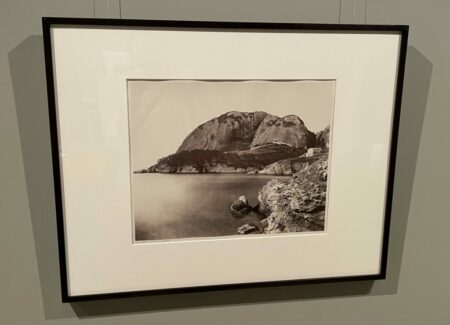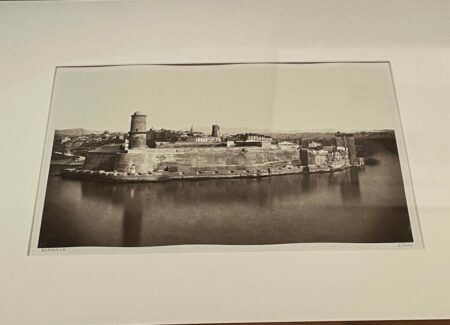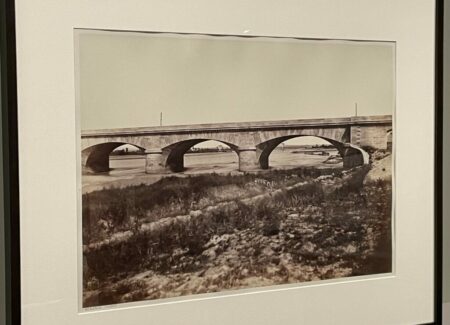JTF (just the facts): A total of 22 black-and-white photographs, framed in dark wood and matted, and hung against light green walls in the main gallery space and the entry area.
The following works are included in the show:
- 1 salt print from pager negative, 1854
- 1 salt print from glass negative, c1854
- 1 albumen print from paper negative, 1855-1858
- 1 salt print from paper negative, 1856
- 2 albumen prints from glass negative, c1856
- 1 albumen print from collodion negative, c1856
- 1 salt print from glass negative, 1858
- 1 albumen print from paper negative, c1859
- 1 coated salt print from paper negative, 1850s
- 1 salt print from glass negative (Baldus or Bisson Frères), 1850s
- 2 albumen prints from paper negative, c1860
- 2 albumen prints from paper negative, c1861
- 4 albumen prints from glass negative, c1861
- 1 albumen print from paper negative, 1861-1863
- 1 albumen print from glass negative, 1861-1863
- 1 heliogravure, 1870s
(Installation shots below.)
Comments/Context: Édouard Baldus was one the masters of 19th century French photography, and an innovator in early architectural photography in particular, but over the past decade, his work has only appeared intermittently in New York. In fact, we likely have to go back almost thirty years to Malcolm Daniel’s Baldus exhibit at the Met (in 1994) to find the last time a comprehensive survey of his photography was on display here. This well-edited sampler-style show remedies those years of inattention to some degree, bringing together nearly two dozen Baldus prints from across various projects and offering a straightforward introduction to the French photographer’s enduring relevance.
While Baldus began his photographic life in the late 1840s, the next two decades, between 1850 and 1870, form the most productive part of his artistic career. These years were filled with governmental and commercial commissions to photograph various locations in France, including architectural monuments and buildings in Paris, landscapes around the country, highlights along the northern route between Paris and the English Channel (as a gift for Queen Victoria), and the railroad infrastructure and key sights between Paris and Marseille in the south (through Lyon and all the way to the Mediterranean Sea.) His approach was systematic and meticulous, with a subtle eye for the impact of technology on the land.
More than half the images in this show are drawn from the so-called PLM album (Paris-Lyon-Méditerranée), published in 1861, and feature landscape views that include marvels of railroad engineering (like bridges, viaducts, and tunnels) as well as city scenes and closer in studies of notable buildings and ancient sites. Baldus’ partial view of the viaduct across the Durance highlights its gently curving arches, while his image of the aqueduct at Roquefavour amplifies its insistent rhythms. Other images are more dominated by the backdrop of rocky mountainscapes, with the train bed in the Ollioules Gorge and the dark entrance of La Nerthe Tunnel nestled into the hillsides. In Arles, Baldus photographed the amphitheater, diving deep into the shadowed darkness of its two-tiered arches; in Orange, Baldus stepped back to look at the facade of the theatre antique, capturing its textural detail and its crumbling brickwork. And when his journey south reached its terminal point along the coast, he made images of the rocky formations jutting into the water at La Ciotat, including the humped forms of the Eagle’s Beak.
During these years, Baldus was continuing to refine his photographic technique, experimenting with different combinations of salt and albumen prints made from paper and glass negatives, and matching them to the aesthetic needs of his image making. Two prints of the coast of Marseille featuring the Château d’If (both from the PLM album) provide an opportunity to look side-by-side at two alternate approaches; both pictures capture glassy sweeps of water, but the paper negative print has a bit more textural mottled cloudiness in the water than the glass negative print.
As a balance to the works from the PLM album, three standout landscapes in this show jump back a handful of years to the mid 1850s. Two likely come from a trip Baldus took to the Auvergne region, where he made a towering landscape view of a valley and waterway at Thiers and a broad scene-setting image of the fortress at Polignac and the surrounding countryside. The third image documents the floods of 1856, and in particular the encroaching water filling the streets of Lyon; it is both a grim historical record and an eerily lovely moment, with watery reflections decorating the open spaces and vacant lots.
Baldus was also making images of monuments in and around Paris in the 1850s, returning to the complex of buildings at the Louvre repeatedly over the years. Images on view here show us the intricacies of the facade of the Bibliothèque Imperial du Louvre, as well as a pair of close up studies of carved stone capitals, turning the decorative elements of architecture at the Louvre into sculptural studies. Another image captures a vaulted interior at Versailles, pulling us down the barrel vaults as we move from shadow to light.
This quick review of Baldus’ imagery successfully makes clear just how much range he had as a photographer, and how he was able to make well known architectural monuments and landscapes around France his own. His photographs capture a country in the midst of technological change, where ancient structures rub against the newfangled lines of progress, forcing the glories of old and new into uneasy coexistence. It is this shifting perspective that alludes to the coming of the modern, and matched with his consistent technical precision, Baldus’ vantage point remains remarkably fresh and challenging.
Collector’s POV: The prints in this show range in price from $1200 to $65000. In the past decade, prints by Baldus have found buyers in the secondary markets at prices between $1000 and $35000, with a few lots at higher prices either unsold or withdrawn.





















